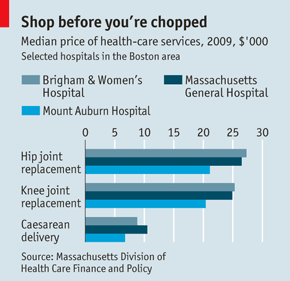The Economist on Consumer-Driven Health
The Economist Magazine finds that inflation in American health spending has been slowing steadily since 2002. It attributes much of that trend to Consumer Driven Health Care.
AMERICANS spent $2.6 trillion on health care in 2010, a staggering 18% of GDP. Yet few of them have the faintest idea what any treatment costs or how it compares with any other treatment. Prices vary wildly and seemingly without reason (see chart). Insurance terms require a dictionary. For most Americans, buying a procedure is akin to choosing a house blindfolded, signing a mortgage in Aramaic, then discovering the price later. Slowly, however, this is changing.
The past decade has seen a shift in how people pay for medicine. Americans’ health spending is growing at a slower pace. This is partly because of the downturn, but not entirely. The rate of growth fell every year between 2002 and 2009, note David Knott and Rodney Zemmel of McKinsey & Company, a consultancy. There are many reasons for this—for example, many costly drugs have lost their patents. But spending habits also seem to be changing.
Full editorial in The Economist.



The RAND Health Insurance Experiment from the 1970s found people consume about 30% less health care when exposed to significant cost-sharing. The experience since 2002 has illustrated that, as cost-sharing increased, workers and individuals slowed their discretionary medical spending. Yet, rather than look for ways to expand cost-sharing and consumer-driven health care to Medicaid, Medicare and other insurance plans, the opposite has occurred.
Proponents of the Affordable Care Act were looking for ways to decrease cost-sharing and increase inefficient cross-subsidies. This initiative was done for the most illogical of reasons: because health care is too expensive.
I don’t know what Romney, Santorum, Gingrich (or most of the other Republicans on the Hill) have in mind to replace the ACA, but I surely hope they will resurrect Coburn’s concept of Vouchers and Tax credits. There are so many many options that could spin off that platform, including Medicare and Medicaid reform.
I have been trying to shop for prices and availability for a cardiac CT angiogram for my spouse while we are staying in the Seattle area. We are from Victoria, BC and don’t want to wait for the system to provide it.
It has been frustrating. Initially, I couldn’t get any pricing. It took being transferred and then telephone tag.
Here is what I found: False Creek Clinic in Vancouver, BC – C$1,800; Northwest Hospital in Seattle – $1,200; Lifeimaging (Seattle Radiology) – $1,166; and Virginia Mason in Seattle – a range from $1,124 to $1,686.
I have no idea why there was a range as they gave me a single code of 75574. I told all that I was paying cash.
I couldn’t figure out how to manuever through the Swedish Medical Center voicemail. Their website, like all save Lifeimaging which stated the price, gave no clue to cost.
The surprise to many was the Canadian price – False Creek is taking advantage of the system in BC.
I wonder what it would be in Bellingham, Washington? Probably between Seattle and Vancouver.
Good news, it seems.
@Brian, we get a lot of Canadians, mostly BC and Ontario. I personally left Canada after my wife was crippled by a 2 year wait for surgery. If you go to http://www.MediBid.ca you can make a request, and get custom pricing for your procedure.
There are some models out there that show what others pay. Healthcare Blue Book comes to mind. It’s a good starting point, but it doesn’t get you a price for YOU. That’s where http://www.MediBid.com helps.
A hu gepart of the problem is the prohibition against public disclosure of specific health care provider fee information by the Justice Department and Federal Trade Commisssion. These prohibitions prevent such things as web based Medical Cost search engines that could identify by Zip Code and CPT code the most affordable prices!
We produce a white paper in May 2006 on the topic of price transparency that is still very relevant “Health Care Cost and Quality Transparency: Improving Health Care Affordability”
See the section – “Price Transparency and Antitrust/Anticompetitive Trade Practice Concerns”
http://www.cdhcinc.com/PublicationDownLoadPage.htm